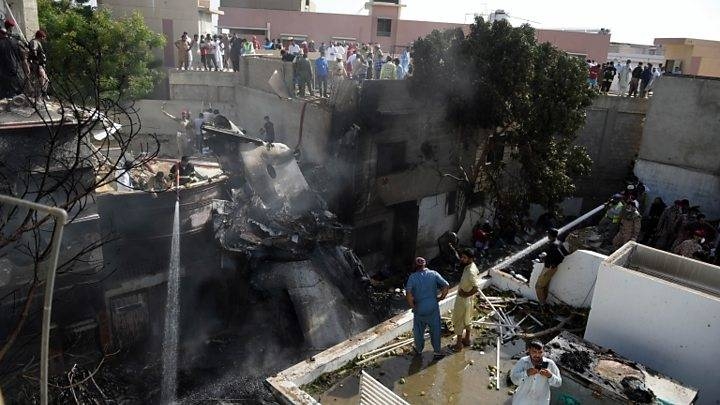
Crashed Pakistan plane's pilot ignored 3 warnings: Report
KARACHI, Pakistan — The pilot of the PIA Pakistan International Airlines (PIA)'s crashed plane ignored three warnings from air traffic controllers about the aircraft's altitude and speed as it approached for landing, according to a news report.
The ill-fated Airbus A-320 that took off from Lahore crashed into one of the densely populated neighborhoods in Karachi, the financial capital of Pakistan on Friday, causing significant damage to houses in the area. Of the 99 people aboard, 97 were killed and only two passengers survived.
The plane was 15 nautical miles from Karachi’s Jinnah International Airport, flying at an altitude of 10,000 feet above the ground instead of 7,000 when the Air Traffic Control (ATC) issued its first warning to lower the plane's altitude, Geo News, a Pakistani news channel, quoted an ATC report as saying.
Instead of lowering the plane's altitude, the pilot responded by saying that he was satisfied. When only 10 nautical miles were left till the Karachi airport, the plane was at an altitude of 7,000 feet instead of 3,000 feet.
The air traffic controllers issued a second warning to the pilot to lower the plane's altitude. However, the pilot responded again by stating that he was satisfied and would handle the situation, saying he was ready for landing, the report claimed.
The report said that the plane had enough fuel to fly for two hours and 34 minutes, while its total flying time was recorded at one hour and 33 minutes.
According to an earlier report prepared by the country's Civil Aviation Authority (CAA), the plane's engines had scraped the runway thrice on the pilot's first attempt to land, causing friction and sparks recorded by the experts.
When the aircraft scraped the ground on the first failed attempt at landing, the engine's oil tank and fuel pump may have been damaged and started to leak, preventing the pilot from achieving the required thrust and speed to raise the aircraft to safety, the report said.
The pilot made a decision "on his own" to undertake a "go-around" after he failed to land the first time. It was only during the go-around that the ATC was informed that landing gear was not deploying, it said.
"The pilot was directed by the air traffic controller to take the aircraft to 3,000 feet, but he managed only 1,800. When the cockpit was reminded to go for the 3,000 feet level, the first officer said 'we are trying'," the report said. — Agencies